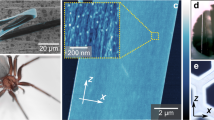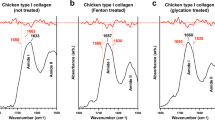Abstract
THE two best known elastic proteins are elastin and resilin. So far, elastin has been, isolated only from vertebrates although the presence of elastin-like material has been reported in several invertebrates1,2. Resilin has been found only in arthropods3. Apart from their amino-acid composition, resilin and elastin differ in the way they are cross linked into three dimensional networks. Thus resilin contains di- and tri-tyrosine formed oxidatively from tyrosine residues4,5 and elastin contains desmosine and isodesmosine6 together with a small amount of lysinonorleucine7, all formed from lysine residues. The presence in foetal elastin of dityrosine has recently been reported8. During an investigation of elastic proteins from other phyla, I noticed that molluscan hinge ligaments contain phenolic compounds, which in several respects resemble dityrosine (Fig. 1). One of these compounds (compound A) has now been isolated and identified as 3,3′-methylene-bistyrosine (Fig. 2). The isolation procedure and the reasons for ascribing the structure in Fig. 2 to the compound are described in this communication; a more detailed description of the properties of the compound will be published later.
This is a preview of subscription content, access via your institution
Access options
Subscribe to this journal
Receive 51 print issues and online access
$199.00 per year
only $3.90 per issue
Buy this article
- Purchase on Springer Link
- Instant access to full article PDF
Prices may be subject to local taxes which are calculated during checkout
Similar content being viewed by others
References
Van Gansen-Semal, P., Nature, 186, 654 (1960).
Elder, H. Y., and Owen, G., J. Zool., 152, 1 (1967).
Andersen, S. O., and Weis-Fogh, T., Adv. Insect Physiol., 2, 1 (1964).
Andersen, S. O., Biochim. Biophys. Acta, 93, 213 (1964).
Andersen, S. O., Acta Physiol. Scand., 66, suppl. 263 (1966).
Thomas, J., Elsden, D. F., and Partridge, S. M., Nature, 200, 651 (1963).
Franzblau, C., Sinex, F. M., Farris, B., and Lampidis, R., Biochem. Biophys. Res. Commun., 21, 575 (1965).
Labella, F. S., Keeley, F., Vivian, S., and Thornhill, D., Biochem. Biophy. Res. Commun., 26, 748 (1967).
Silaev, A. B., Katrukha, G. S., and Stepanov, C. M., Biokhimiya, 26, 7 (1961).
Godfrey, L. E. A., Hawkins, E. G. E., and Jenkins, P. A., J. Appl. Chem., 7, 440 (1957).
Brown, C. H., Quart. J. Micros. Sci., 93, 487 (1952).
Author information
Authors and Affiliations
Rights and permissions
About this article
Cite this article
ANDERSEN, S. Isolation of a New Type of Cross Link from the Hinge Ligament Protein of Molluscs. Nature 216, 1029–1030 (1967). https://doi.org/10.1038/2161029a0
Received:
Published:
Issue Date:
DOI: https://doi.org/10.1038/2161029a0
Comments
By submitting a comment you agree to abide by our Terms and Community Guidelines. If you find something abusive or that does not comply with our terms or guidelines please flag it as inappropriate.



